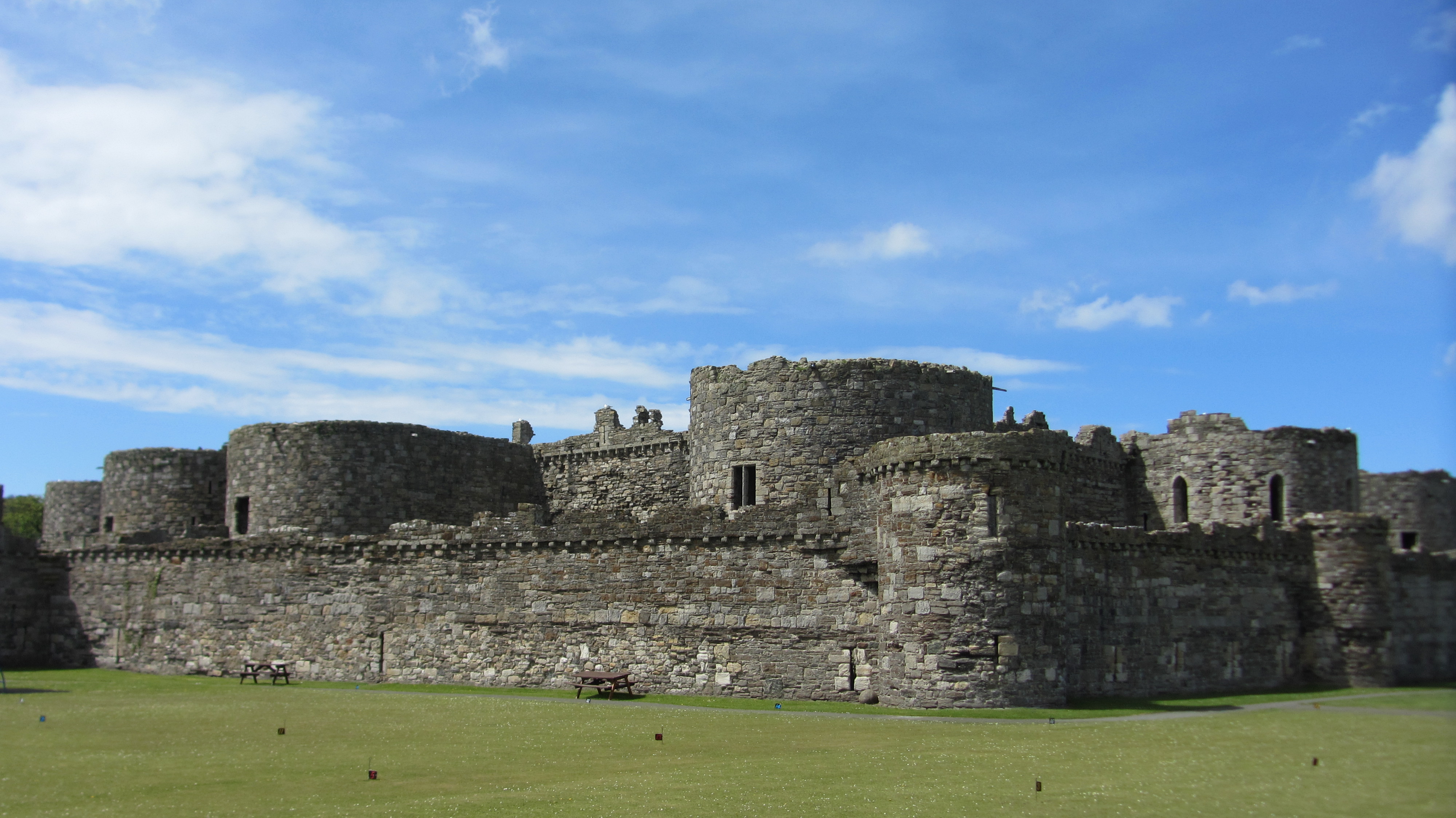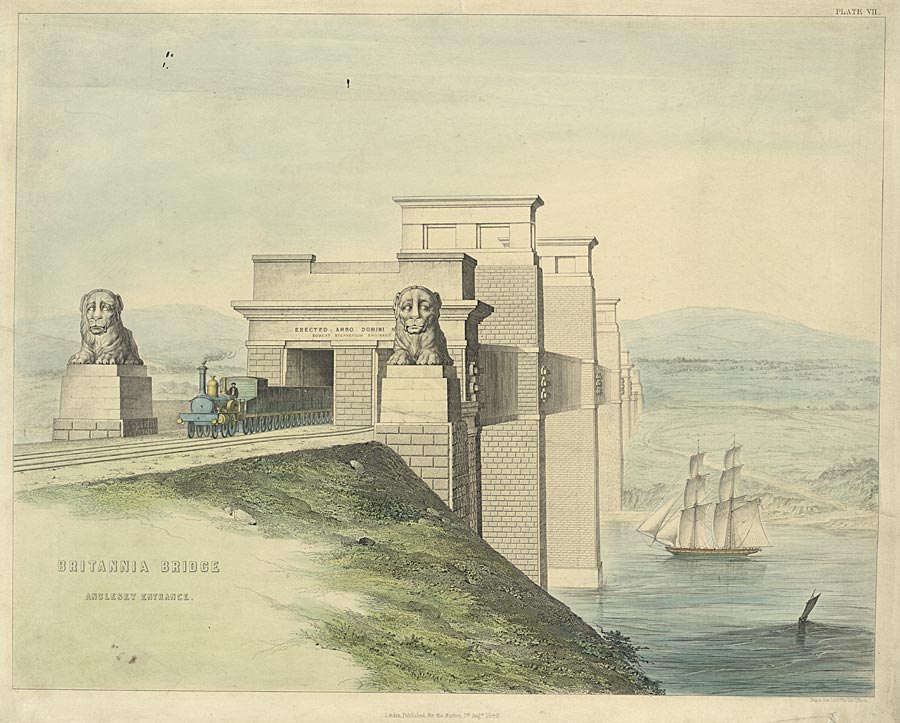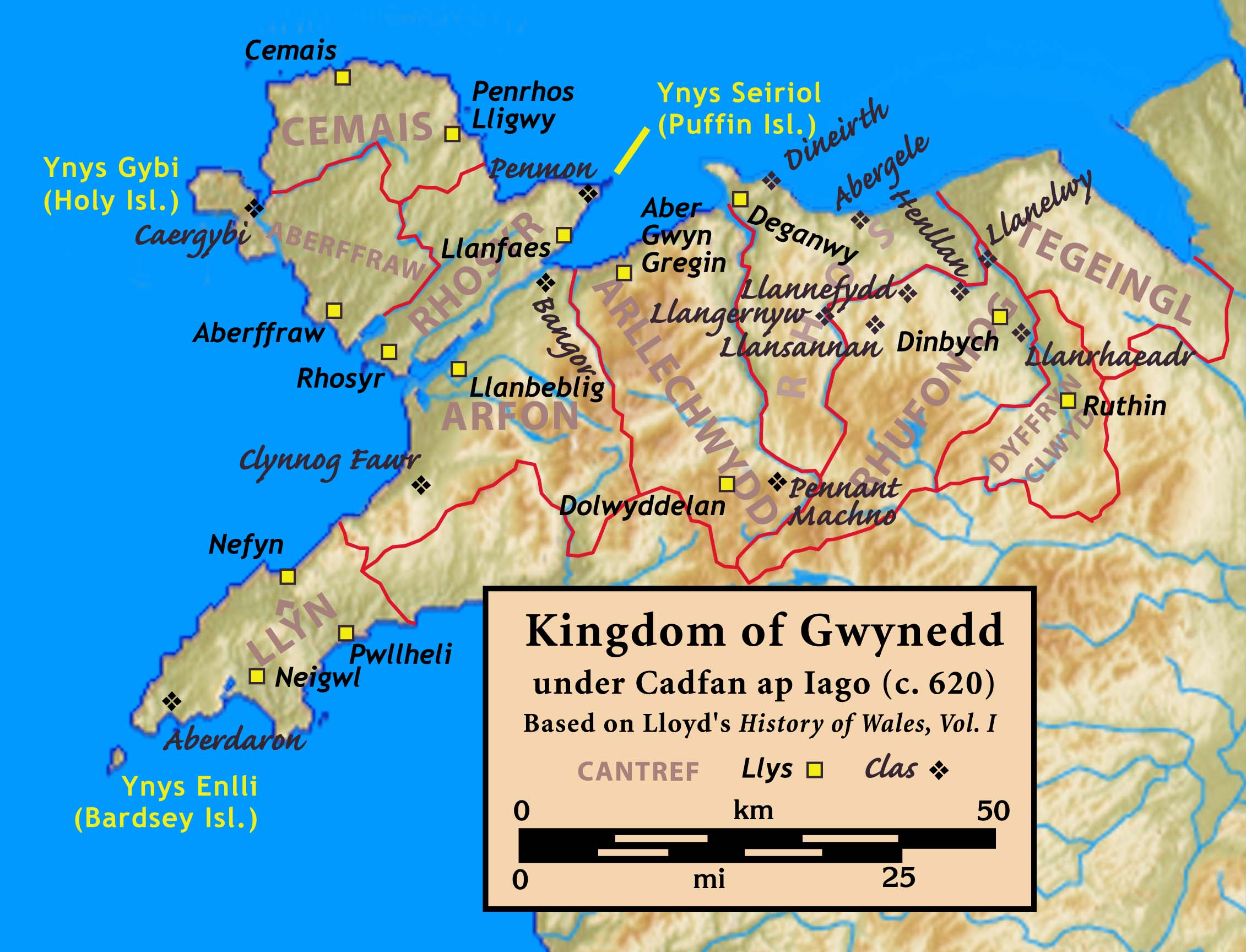|
Llanfairpwllgwyngyll
Llanfairpwllgwyngyll or Llanfair Pwllgwyngyll (), often shortened to Llanfairpwll and sometimes to Llanfair PG, is a village and community on the Isle of Anglesey, Wales. It is located on the Menai Strait, next to the Britannia Bridge. At the 2011 Census the population was 3,107, of whom 71% could speak Welsh. In 2021, the population decreased to 2,900 (rounded to the nearest 100). It is the sixth largest settlement in the county by population. () is a lengthened form of the community name, used in some contexts. With 58 characters split into 18 syllables, the small town is purported to have the longest name in Europe and the second longest one-word place name in the world. History The area has been settled since the Neolithic era (4000–2000 BC), with subsistence agriculture and fishing the most common occupations for much of its early history. The island of Anglesey was at that point reachable only by boat across the Menai Strait. A largely destroyed, collapsed dolmen ... [...More Info...] [...Related Items...] OR: [Wikipedia] [Google] [Baidu] |
Isle Of Anglesey
Anglesey ( ; ) is an island off the north-west coast of Wales. It forms the bulk of the Principal areas of Wales, county known as the Isle of Anglesey, which also includes Holy Island, Anglesey, Holy Island () and some islets and Skerry, skerries. The county borders Gwynedd across the Menai Strait to the southeast, and is otherwise surrounded by the Irish Sea. Holyhead is the largest town, and the administrative centre is Llangefni. The county is part of the Preserved counties of Wales, preserved county of Gwynedd. Anglesey is the northernmost county in Wales. The Isle of Anglesey has an area of and a population of in . After Holyhead (12,103), the largest settlements are Llangefni (5,500) and Amlwch (3,967). The economy of the county is mostly based on agriculture, energy, and tourism, the latter especially on the coast. Holyhead is also a major ferry port for Dublin, Ireland. The county has the second-highest percentage of Welsh language, Welsh speakers in Wales, at 57.2%, ... [...More Info...] [...Related Items...] OR: [Wikipedia] [Google] [Baidu] |
List Of Long Place Names
This is a list of long place names. Single-word names 25 letters or more 20–24 letters 14–19 letters Names with spaces or hyphens, by country * Krungthepmahanakhon Amonrattanakosin Mahintharayutthaya Mahadilokphop Noppharatratchathaniburirom Udomratchaniwetmahasathan Amonphimanawatansathit Sakkathattiyawitsanukamprasit (176 letters, 7 spaces) Full name of Bangkok, Thailand (Thai: กรุงเทพมหานคร อมรรัตนโกสินทร์ มหินทรายุธยา มหาดิลกภพ นพรัตนราชธานีบูรีรมย์ อุดมราชนิเวศน์มหาสถาน อมรพิมานอวตารสถิต สักกะทัตติยวิษณุกรรมประสิทธิ์, 132 letters) * Some long Thai place names containing at least 20 letters are: ** Bang Pakong Phrom Thep Rangsan (26 letters, 4 spaces) subdistrict municipality, Bang Pakong distr ... [...More Info...] [...Related Items...] OR: [Wikipedia] [Google] [Baidu] |
List Of Anglesey Towns By Population
This is a guide to the size of settlements in Anglesey based on 2021 census data. The entire population of Anglesey is 68,878. {, class="wikitable sortable" , - !Rank !Settlement !Population (2021) , - , 1 , Holyhead , 11,760 , - , 2 , Llangefni , 5,261 , - , 3 , Amlwch , 3,147 , - , 4 , Menai Bridge , 3,046 , - , 5 , Llanfairpwllgwyngyll , 2,907 , - , 6 , Benllech , 2,072 , - , 7 , Valley A valley is an elongated low area often running between hills or mountains and typically containing a river or stream running from one end to the other. Most valleys are formed by erosion of the land surface by rivers or streams over ... , 2,005 , - , 8 , Gaerwen , 1,279 , - References2021 Census [...More Info...] [...Related Items...] OR: [Wikipedia] [Google] [Baidu] |
Marquess Of Anglesey's Column
The Marquess of Anglesey's Column (also known as Anglesey Column or by the Welsh name ''Tŵr Marcwis'') is a Doric column near the Menai Strait in Wales. It is dedicated to Henry William Paget (the first Marquess of Anglesey) to commemorate his valour in the Napoleonic Wars. The column is a Grade II* listed building. The monument (designed by Thomas Harrison) was erected close to Paget's country retreat at Plas Newydd, in 1817. On the foundation stone there is an inscription in English, Welsh and Latin: The inhabitants of the counties of Anglesey and Caernarvon have erected this column in grateful commemoration of the distinguished military achievements of their countryman HENRY WILLIAM, MARQUESS OF ANGLESEY the leader of the British Cavalry in Spain throughout the arduous Campaign of 1807 and Second in Command of the Armies confederated against France at the memorable battle of Waterloo on the 18th of June 1815. Thomas Harrison Architect. During the battle of Waterloo, Pa ... [...More Info...] [...Related Items...] OR: [Wikipedia] [Google] [Baidu] |
Britannia Bridge
Britannia Bridge () is a bridge in Wales that crosses the Menai Strait between the Isle of Anglesey and city of Bangor, Gwynedd, Bangor. It was originally designed and built by the noted railway engineer Robert Stephenson as a tubular bridge of wrought iron rectangular box-section spans for carrying rail traffic. Its importance was to form a critical link of the Chester and Holyhead Railway's route, enabling trains to directly travel between London and the port of Holyhead, thus facilitating a sea link to Dublin, Ireland. Decades before the building of the Britannia Bridge, the Menai Suspension Bridge had been completed, but this structure carried a road rather than track; there was no rail connection to Anglesey before its construction. After many years of deliberation and proposals, on 30 June 1845, a Act of Parliament#Bills, Parliamentary Bill covering the construction of the Britannia Bridge received royal assent. At the British Admiralty, Admiralty's insistence, the bridge ... [...More Info...] [...Related Items...] OR: [Wikipedia] [Google] [Baidu] |
Kingdom Of Gwynedd
The Kingdom of Gwynedd (Medieval Latin: ; Middle Welsh: ) was a Wales in the Early Middle Ages, Welsh kingdom and a Roman Empire Succession of states, successor state that emerged in sub-Roman Britain in the 5th century during the Anglo-Saxon settlement of Britain. Based in northwest Wales, the list of rulers of Gwynedd, rulers of Gwynedd repeatedly rose to dominance and were acclaimed as "King of the Britons" before losing their power in civil wars or invasions. The kingdom of Gruffydd ap Llywelynthe King of Wales from 1055 to 1063was shattered by a Timeline of conflict in Anglo-Saxon Britain, Saxon invasion in 1063 just prior to the Norman invasion of Wales, but the House of Aberffraw restored by Gruffudd ap Cynan slowly recovered and Llywelyn the Great of Gwynedd was able to proclaim the Principality of Wales at the Aberdyfi gathering of Welsh princes in 1216. In 1277, the Treaty of Aberconwy between Edward I of England and Llywelyn's grandson Llywelyn ap Gruffudd granted pe ... [...More Info...] [...Related Items...] OR: [Wikipedia] [Google] [Baidu] |
Medieval
In the history of Europe, the Middle Ages or medieval period lasted approximately from the 5th to the late 15th centuries, similarly to the post-classical period of World history (field), global history. It began with the fall of the Western Roman Empire and transitioned into the Renaissance and the Age of Discovery. The Middle Ages is the middle period of the three traditional divisions of Western history: classical antiquity, the medieval period, and the modern period. The medieval period is itself subdivided into the Early Middle Ages, Early, High Middle Ages, High, and Late Middle Ages. Population decline, counterurbanisation, the collapse of centralised authority, invasions, and mass migrations of tribes, which had begun in late antiquity, continued into the Early Middle Ages. The large-scale movements of the Migration Period, including various Germanic peoples, formed new kingdoms in what remained of the Western Roman Empire. In the 7th century, North Africa and the ... [...More Info...] [...Related Items...] OR: [Wikipedia] [Google] [Baidu] |
Boudicca
Boudica or Boudicca (, from Brythonic * 'victory, win' + * 'having' suffix, i.e. 'Victorious Woman', known in Latin chronicles as Boadicea or Boudicea, and in Welsh as , ) was a queen of the ancient British Iceni tribe, who led a failed uprising against the conquering forces of the Roman Empire in AD 60 or 61. She is considered a British national heroine and a symbol of the struggle for justice and independence. Boudica's husband Prasutagus, with whom she had two daughters, ruled as a nominally independent ally of Rome. He left his kingdom jointly to his daughters and to the Roman emperor in his will. When he died, his will was ignored, and the kingdom was annexed and his property taken. According to the Roman historian Tacitus, Boudica was flogged and her daughters raped. The historian Cassius Dio wrote that previous imperial donations to influential Britons were confiscated and the Roman financier and philosopher Seneca called in the loans he had forced on the reluc ... [...More Info...] [...Related Items...] OR: [Wikipedia] [Google] [Baidu] |
Gaius Suetonius Paulinus
Gaius Suetonius Paulinus (fl. AD 40–69) was a Roman general best known as the commander who defeated Boudica and her army during the Boudican revolt. Early life Little is known of Suetonius' family, but it likely came from Pisaurum (modern Pesaro), a town on the Adriatic coast of Italy. Mauretanian campaign Having served as ''praetor'' in 40 AD, Suetonius was appointed governor of Mauretania (modern northern Morocco) the following year. In collaboration with Gnaeus Hosidius Geta, he suppressed the revolt led by Aedemon in the mountainous province that arose from the execution of the local ruler by Caligula. In 41 AD Suetonius was the first Roman commander to lead troops across the Atlas Mountains, and Pliny the Elder quotes his description of the area in his ''Natural History''. Governor of Britain In 58 AD, before being consul,A. R. Birley, "Suetonius Paullinus, Gaius (fl. c.AD 40–69)", ''Oxford Dictionary of National Biography'', Oxford University Press, 2004; online e ... [...More Info...] [...Related Items...] OR: [Wikipedia] [Google] [Baidu] |
Neolithic
The Neolithic or New Stone Age (from Ancient Greek, Greek 'new' and 'stone') is an archaeological period, the final division of the Stone Age in Mesopotamia, Asia, Europe and Africa (c. 10,000 BCE to c. 2,000 BCE). It saw the Neolithic Revolution, a wide-ranging set of developments that appear to have arisen independently in several parts of the world. This "Neolithic package" included the History of agriculture, introduction of farming, domestication of animals, and change from a hunter-gatherer lifestyle to one of sedentism, settlement. The term 'Neolithic' was coined by John Lubbock, 1st Baron Avebury, Sir John Lubbock in 1865 as a refinement of the three-age system. The Neolithic began about 12,000 years ago, when farming appeared in the Epipalaeolithic Near East and Mesopotamia, and later in other parts of the world. It lasted in the Near East until the transitional period of the Chalcolithic (Copper Age) from about 6,500 years ago (4500 BCE), marked by the development ... [...More Info...] [...Related Items...] OR: [Wikipedia] [Google] [Baidu] |
Royal Commission On The Ancient And Historical Monuments Of Wales
The Royal Commission on the Ancient and Historical Monuments of Wales (RCAHMW; ; ), established in 1908, is a Welsh Government sponsored body concerned with some aspects of the archaeological, architectural and historic environment of Wales. It is based in Aberystwyth. The RCAHMW maintains and curates the National Monuments Record of Wales (NMRW), an archive with an online platform called Coflein. Professor Nancy Edwards is Chair of the Commissioners. Mission statement The Royal Commission has a national role in the management of the archaeological, built and maritime heritage of Wales, as an originator, curator and supplier of information for individual, corporate and governmental decision-makers, researchers and the general public. To this end it: * Surveys, interprets and records the man-made environment of Wales * Compiles, maintains and curates the National Monuments Record of Wales * Promotes an understanding of this information by all appropriate means The Royal Co ... [...More Info...] [...Related Items...] OR: [Wikipedia] [Google] [Baidu] |



